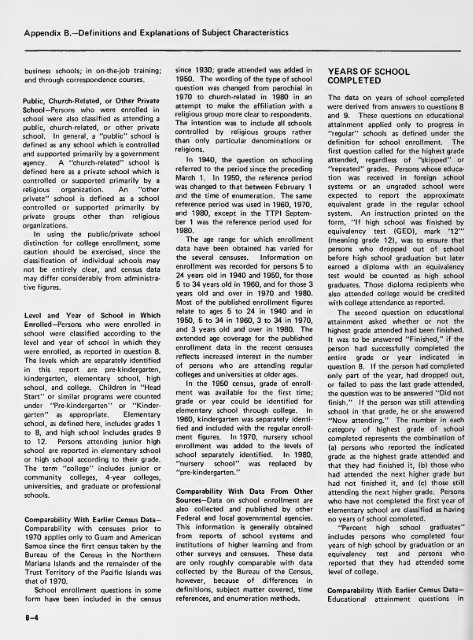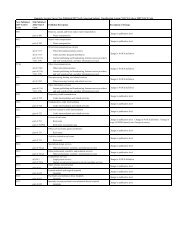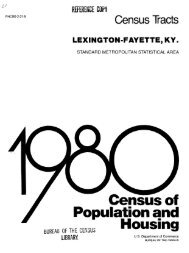1980 census of population. Characteristics of the ... - Census Bureau
1980 census of population. Characteristics of the ... - Census Bureau
1980 census of population. Characteristics of the ... - Census Bureau
You also want an ePaper? Increase the reach of your titles
YUMPU automatically turns print PDFs into web optimized ePapers that Google loves.
Appendix B.—Definitions and Explanations <strong>of</strong> Subject <strong>Characteristics</strong><br />
business schools; in on-<strong>the</strong>-job training;<br />
and through correspondence courses.<br />
Public, Church-Related, or O<strong>the</strong>r Private<br />
School— Persons who were enrolled in<br />
school were also classified as attending a<br />
public, church-related, or o<strong>the</strong>r private<br />
school. In general, a "public" school is<br />
defined as any school which is controlled<br />
and supported primarily by a government<br />
agency. A "church-related" school is<br />
defined here as a private school which is<br />
controlled or supported primarily by a<br />
religious organization. An "o<strong>the</strong>r<br />
private" school is defined as a school<br />
controlled or supported primarily by<br />
private groups o<strong>the</strong>r than religious<br />
organizations.<br />
In using <strong>the</strong> public/private school<br />
distinction for college enrollment, some<br />
caution should be exercised, since <strong>the</strong><br />
classification <strong>of</strong> individual schools may<br />
not be entirely clear, and <strong>census</strong> data<br />
may differ considerably from administra-<br />
tive figures.<br />
Level and Year <strong>of</strong> School in Which<br />
Enrolled— Persons who were enrolled in<br />
school were classified according to <strong>the</strong><br />
level and year <strong>of</strong> school in which <strong>the</strong>y<br />
were enrolled, as reported in question 8.<br />
The levels which are separately identified<br />
in this report are pre-kindergarten,<br />
kindergarten, elementary school, high<br />
school, and college. Children in "Head<br />
Start" or similar programs were counted<br />
under "Pre-kindergarten" or "Kinder-<br />
garten" as appropriate. Elementary<br />
school, as defined here, includes grades 1<br />
to 8, and high school includes grades 9<br />
to 12. Persons attending junior high<br />
school are reported in elementary school<br />
or high school according to <strong>the</strong>ir grade.<br />
The term "college" includes junior or<br />
community colleges, 4-year colleges,<br />
universities, and graduate or pr<strong>of</strong>essional<br />
schools.<br />
Comparability With Earlier <strong>Census</strong> Data-<br />
Comparability with <strong>census</strong>es prior to<br />
1970 applies only to Guam and American<br />
Samoa since <strong>the</strong> first <strong>census</strong> taken by <strong>the</strong><br />
<strong>Bureau</strong> <strong>of</strong> <strong>the</strong> <strong>Census</strong> in <strong>the</strong> Nor<strong>the</strong>rn<br />
Mariana Islands and <strong>the</strong> remainder <strong>of</strong> <strong>the</strong><br />
Trust Territory <strong>of</strong> <strong>the</strong> Pacific Islands was<br />
that <strong>of</strong> 1970.<br />
School enrollment questions in some<br />
form have been included in <strong>the</strong> <strong>census</strong><br />
B-4<br />
since 1930; grade attended was added in<br />
1950. The wording <strong>of</strong> <strong>the</strong> type <strong>of</strong> school<br />
question was changed from parochial in<br />
1970 to church-related in <strong>1980</strong> in an<br />
attempt to make <strong>the</strong> affiliation yvith a<br />
religious group more clear to respondents.<br />
The intention was to include all schools<br />
controlled by religious groups ra<strong>the</strong>r<br />
than only particular denominations or<br />
religions.<br />
In 1940, <strong>the</strong> question on schooling<br />
referred to <strong>the</strong> period since <strong>the</strong> preceding<br />
March 1. In 1950, <strong>the</strong> reference period<br />
was changed to that between February 1<br />
and <strong>the</strong> time <strong>of</strong> enumeration. The same<br />
reference period was used in 1960, 1970,<br />
and <strong>1980</strong>, except in <strong>the</strong> TTPI Septem-<br />
ber 1 was <strong>the</strong> reference period used for<br />
<strong>1980</strong>.<br />
The age range for which enrollment<br />
data have been obtained has varied for<br />
<strong>the</strong> several <strong>census</strong>es. Information on<br />
enrollment was recorded for persons 5 to<br />
24 years old in 1940 and 1950, for those<br />
5 to 34 years old in 1960, and for those 3<br />
years old and over in 1970 and <strong>1980</strong>.<br />
Most <strong>of</strong> <strong>the</strong> published enrollment figures<br />
relate to ages 5 to 24 in 1940 and in<br />
1950, 5 to 34 in 1960, 3 to 34 in 1970,<br />
and 3 years old and over in <strong>1980</strong>. The<br />
extended age coverage for <strong>the</strong> published<br />
enrollment data in <strong>the</strong> recent <strong>census</strong>es<br />
reflects increased interest in <strong>the</strong> number<br />
<strong>of</strong> persons who are attending regular<br />
colleges and universities at older ages.<br />
In <strong>the</strong> 1950 <strong>census</strong>, grade <strong>of</strong> enrollment<br />
was available for <strong>the</strong> first time;<br />
grade or year could be identified for<br />
elementary school through college. In<br />
1960, kindergarten was separately identi-<br />
fied and included with <strong>the</strong> regular enrollment<br />
figures. In 1970, nursery school<br />
enrollment was added to <strong>the</strong> levels <strong>of</strong><br />
school separately identified. In <strong>1980</strong>,<br />
"nursery school" was replaced by<br />
"pre-kindergarten."<br />
Comparability With Data From O<strong>the</strong>r<br />
Sources— Data on school enrollment are<br />
also collected and published by o<strong>the</strong>r<br />
Federal and local governmental agencies.<br />
This information is generally obtained<br />
from reports <strong>of</strong> school systems and<br />
institutions <strong>of</strong> higher learning and from<br />
o<strong>the</strong>r surveys and <strong>census</strong>es. These data<br />
are only roughly comparable with data<br />
collected by <strong>the</strong> <strong>Bureau</strong> <strong>of</strong> <strong>the</strong> <strong>Census</strong>,<br />
however, because <strong>of</strong> differences in<br />
definitions, subject matter covered, time<br />
references, and enumeration methods.<br />
YEARS OF SCHOOL<br />
COMPLETED<br />
The data on years <strong>of</strong> school completed<br />
were derived from answers to questions 8<br />
and 9. These questions on educational<br />
attainment applied only to progress in<br />
"regular" schools as defined under <strong>the</strong><br />
definition for school enrollment. The<br />
first question called for <strong>the</strong> highest grade<br />
attended, regardless <strong>of</strong> "skipped" or<br />
"repeated" grades. Persons whose educa-<br />
tion was received in foreign school<br />
systems or an ungraded school were<br />
expected to report <strong>the</strong> approximate<br />
equivalent grade in <strong>the</strong> regular school<br />
system. An instruction printed on <strong>the</strong><br />
form, "If high school was finished by<br />
equivalency test (GED), mark '12"'<br />
(meaning grade 12), was to ensure that<br />
persons who dropped out <strong>of</strong> school<br />
before high school graduation but later<br />
earned a diploma with an equivalency<br />
test would be counted as high school<br />
graduates. Those diploma recipients who<br />
also attended college would be credited<br />
with college attendance as reported.<br />
The second question on educational<br />
attainment asked whe<strong>the</strong>r or not <strong>the</strong><br />
highest grade attended had been finished.<br />
It was to be answered "Finished," if <strong>the</strong><br />
person had successfully completed <strong>the</strong><br />
entire grade or year indicated in<br />
question 8. If <strong>the</strong> person had completed<br />
only part <strong>of</strong> <strong>the</strong> year, had dropped out,<br />
or failed to pass <strong>the</strong> last grade attended,<br />
<strong>the</strong> question was to be answered "Did not<br />
finish." If <strong>the</strong> person was still attending<br />
school in that grade, he or she answered<br />
"Now attending." The number in each<br />
category <strong>of</strong> highest grade <strong>of</strong> school<br />
completed represents <strong>the</strong> combination <strong>of</strong><br />
(a) persons who reported <strong>the</strong> indicated<br />
grade as <strong>the</strong> highest grade attended and<br />
that <strong>the</strong>y had finished it, (b) those who<br />
had attended <strong>the</strong> next higher grade but<br />
had not finished it, and (c) those still<br />
attending <strong>the</strong> next higher grade. Persons<br />
who have not completed <strong>the</strong> first year <strong>of</strong><br />
elementary school are classified as having<br />
no years <strong>of</strong> school completed.<br />
"Percent high school graduates"<br />
includes persons who completed four<br />
years <strong>of</strong> high school by graduation or an<br />
equivalency test and persons who<br />
reported that <strong>the</strong>y had attended some<br />
level <strong>of</strong> college.<br />
Comparability With Earlier <strong>Census</strong> Data-<br />
Educational attainment questions in





